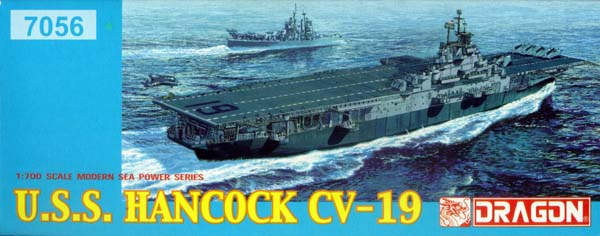
Reviewed by Timothy Dike

| Extracted from the DANFS (Dictionary of American Naval
Fighting Ship)
The USS Hancock was a Ticonderoga class version of the famous Essex class carrier. Mass produced during the war to ensure US Navy aircraft could reach far into the Japanese held islands these carriers evolved as the war progressed. This one was launched 24 January 1944 and commissioned 15 April 1944. After fitting out in the Boston Navy Yard and shake-down training off Trinidad and Venezuela, Hancock returned to Boston for alterations 9 July. She departed Boston 31 July en route to Pearl Harbor via the Panama Canal and San Diego, and from th ere sailed 24 September to join Admiral W. F. Halsey's 3d Fleet at Ulithi 5 October. She was assigned to Rear Admiral Bogan's Carrier Task Group 38.2. Hancock got underway the following afternoon for a rendezvous point 375 miles west of the Marianas where units of Vice Admiral Mitscher's Fast Carrier Task Force 38 were assembling in preparation for the daring cruise to raid Japanese air and se a bases in the Ryukyus, Formosa, and the Philippines. Thus enemy air power was paralyzed during General MacArthur's invasion of Leyte. When the armada arrived off the Ryukyu Islands 10 October 1944, Hancock's planes rose off her deck to wreak destr uction upon Okinawan airfields and shipping. Her planes destroyed 7 enemy aircraft on the ground and assisted in the destruction of a submarine tender, 12 torpedo boats, 2 midget submarines, 4 cargo ships, and a number of sampans. Next on the agenda were Formosan air bases where 12 October Hancock s pilots downed six enemy planes and destroyed nine more on the ground. She also reported one cargo ship definitely sunk, three probably destroyed, and several others damaged. As they repelled an enemy air raid that evening, Hancock's gunners accounted for a Japanese plane and drove countless others off during 7 hours of uninterrupted general quarters. The following morning her planes resumed their assault, knocking o ut ammunition dumps, hangars, barracks, and industrial plants ashore and damaging an enemy transport. As Japanese planes again attacked the Americans during their second night off Formosa, Hancock's antiaircraft fire brought down another raider whi ch splashed about 500 yards off her eight deck. On the morning of the third day of operations against this enemy stronghold Hancock lashed out again at airfields and shipping before retiring to the southeast with her task force. As the American shi ps withdrew a heavy force of Japanese aircraft roared in for a parting crack. One dropped a bomb off Hancock's port bow a few seconds before the carrier's guns splashed her into the sea. Another bomb penetrated a gun platform but exploded harmlessl y in the water. The surviving attackers then turned tail, and the task force was thereafter unmolested as they sailed toward the Philippines to support the landings at Leyte. On 18 October she launched planes against airfields and shipping at Laoag, Aparri, and Camiguin Island in Northern Luzon. Her planes struck the islands of Cebu, Panay, Negros, and Masbate, pounding enemy airfields and shipping. The next day she retired toward Ulithi with Vice Admiral John S. McCain's Carrier Task Group 38.1. She received orders 23 October to turn back to the area off Samar to assist in the search for units of the Japanese fleet reportedly closing Leyte to challenge the American fleet and to destroy amphibious forces which were struggling to take the island from Japan. Hancock did not reach Samar in time to assist the heroic escort carriers and destroyers of "Taffy 3" during the main action of the Battle off Samar but her planes did manage to lash the fleeing Japanese Center Force as it passed throug h the San Bernardino Straits. Hancock then rejoined Rear Admiral Bogan's Task Group with which she struck airfields and shipping in the vicinity of Manila 29 October 1944. During operations through 19 November, her planes gave direct support to adv ancing Army troops and attacked Japanese shipping over a 350-mile area. She became flagship of Fast Carrier Task Force 38,17 November 1944 when Vice Admiral McCain came on board. Unfavorable weather prevented operations until 25 November when an enemy aircraft roared toward Hancock in a suicide dive out of the sun. Antiaircraft fire exploded the plane some 300 feet above the ship but a section of its fuselage landed amid ships and a part of the wing hit the flight deck and burst into flames. Prompt and skillful teamwork quickly extinguished the blaze and prevented serious damage. Hancock returned to Ulithi 27 November and departed from that island with her task group to maintain air patrol over enemy airfields on Luzon to prevent enemy suicide attacks on amphibious vessels of the landing force in Mindoro. The first strik es were launched 14 December against Clark and Angeles Airfields as well as enemy ground targets on Salvador Island. The next day her planes struck installations at Masinloc, San Fernando, and [233] Cabatuan, while fighter patrols kept the Japanese airmen down. Her planes also attacked shipping in Manila Bay. Hancock encountered a severe typhoon 17 December and rode out the storm in waves which broke over her flight deck, some 55 feet above her waterline. She put into Ulithi 24 December and got underway 6 days later to attack airfields and shipping a round the South China Sea. Her planes struck hard blows at Luzon airfields 7 and 8 January and turned their attention back to Formosa 9 January hitting fiercely at airfields and the Tokyo Seaplane Station. An enemy convoy north of Camranh Bay, Indochina, was the next victim with 2 ships sunk and 11 damaged. That afternoon Hancock launched strikes against airfields at Saigon and shipping on the northeastern bulge of French Indochina. Strikes by the fast and mobile carrier force continued through 16 January, hitting Hainan Island in the Gulf of Tonkin, the Pescadores Islands, and shipping in the harbor of Hong Kong. Raids against Formosa were resumed 20 January 1945. The next afternoon one of her planes returning from a sortie made a normal landing, taxied to a point abreast of the island, and disintegrated in a blinding explosion which killed 50 men and injured 75 others. Again outstanding work quickly brought the fires under control in time to land other planes which were still aloft. She returned to formation and launched strikes against Okinawa the next morning. Hancock reached Ulithi 25 January where Vice Admiral McCain left the ship and relinquished command of the 5th Fleet. She sortied with the ships of her task group 10 February and launched strikes against airfields in the vicinity of Tokyo 16 Febr uary. During that day her air group downed 71 enemy planes, and accounted for 12 more the next. Her planes hit the enemy naval bases at Chichi Jima and Haha Jima 19 February. These raids were conducted to isolate Iwo Jima from air and sea support when mar ines hit the beaches of that island to begin one of the most bloody and fierce campaigns of the war. Hancock took station off this island to provide tactical support through 22 February, hitting enemy airfields and strafing Japanese troops ashore. Returning to waters off the enemy home islands, Hancock launched her planes against targets on northern Honshu, making a diversionary raid on the Nansei-shoto islands 1 March before returning to Ulithi 4 March. Back in Japanese waters Hancock Joined other carriers in strikes against Kyushu airfields, southwestern Honshu and shipping in the Inland Sea of Japan, 18 March 1945. Hancock was refueling destroyer Halsey Powell 20 March when sui cide planes attacked the task force. One plane dove for the two ships but was disintegrated by gunfire when about 700 feet overhead. Fragments of the plane hit Hancock's deck while its engine and bomb crashed the fantail of the destroyer. Hancoc k's gunners shot down another plane as it neared the release point of its bombing run on the carrier. Hancock was reassigned to Carrier Task Group 58.3 with which she struck the Nansei-shoto islands 23 through 27 March and Minami Daito Jima and Kyushu at the end of the month. When the 10th Army landed on the western coast of Okinawa 1 April Hancock was on hand to provide close air support. A suicide plane cartwheeled across her flight deck 7 April and crashed into a group of planes while its bomb hit the port catapul t to cause a tremendous explosion. Although 62 men were killed and 71 wounded, heroic efforts doused the fires within half an hour enabling her to be back in action before an hour had passed. Hancock was detached from her task group 9 April and steamed to Pearl Harbor for repairs. She sailed back into action 13 June and left lethal calling cards at Wake Island 20 June en route to the Philippines. Hancock sailed from San Pedro Bay with the other carriers 1 July and attacked Tokyo airfields 10 July. She continued to operate in Japanese waters until she received confirmation of Japan's capitulation 15 August 1945 when she recalled her planes from their deadly missions before they reached their targets. However planes of her photo division were attacked by seven enemy aircraft over Sagami Wan. Three were shot down and a fourth escaped in a trail of smoke. Later that afternoon planes of Hancock's air patrol shot down a Japan ese torpedo plane as it dived on a British task force. Her planes flew missions over Japan in search of prison camps, dropping supplies and medicine, 25 August. Information collected during these flights led to landings under command of Commodore R. W. S impson which brought doctors and supplies to all Allied prisoner of war encampments. When the formal surrender of the Japanese Imperial Government was signed on board battleship Missouri, Hancock's planes flew overhead. The carrier entered Tokyo Bay 10 September 1945 and sailed 30 September embarking 1,500 passengers at O kinawa for transportation to San Pedro, California, where she arrived 21 October. Hancock was fitted out for "Magic Carpet" duty at San Pedro and sailed for Seeadler Harbor, Manus Admiralty Islands, 2 November. On her return voyage she carried 4,00 0 passengers who were debarked at San Diego 4 December. A week later Hancock departed for her second "Magic Carpet" voyage, embarking 3,773 passengers at Manila for return to Alameda, Calif., 20 January 1946. She embarked Air Group 7 at San Diego 1 8 February for air operations off the coast of California. She sailed from San Diego 11 March to embark men of two air groups and aircraft at Pearl Harbor for transportation to Saipan, arriving 1 April 1946. After receiving two other air groups on board a t Saipan, she loaded a cargo of aircraft at Guam and steamed by way of Pearl Harbor to Alameda, Calif., arriving 23 April 1946. She then steamed to Seattle, Wash., 29 April to await inactivation. The proud ship decommissioned and entered the reserve fleet at Bremerton, Wash. Hancock commenced conversion and modernization to an attack aircraft carrier in Puget Sound 15 December 1951 and was reclassified CVA-19, 1 October 1952. She recommissioned 15 February 1954, Captain W. S. Butts in command. She was the first carr ier of the United States Fleet with steam catapults capable of launching high performance jets. She was off San Diego 7 May 1954 for operations along the coast of California that included the launching 17 June of the first aircraft to take off a United States carrier by means of a steam catapult. After a year of operations along the Pacific coast that included testing of Sparrow I and Regulus missiles and Cutlass Jet aircraft, she sailed 10 August 1955 for 7th Fleet operations ranging from the shores of Japan to the Philippines and Okinawa. She returned to San Diego 15 March 1956 and decommission ed 13 April for conversion that included the installation of an angled flight deck. Hancock recommissioned 15 November 1956 for training out of San Diego until 6 April 1957 when she again sailed for Hawaii and the Far East. She returned to San Diego 18 September 1957 and again departed for Japan 15 February 1958. She was a unit of powerful carrier task groups taking station off Taiwan when the Nationalist Chinese islands of Quemoy and Matsu were threatened with Communist invasion in August 1958. The carrier returned to San Diego 2 October 1958 for overhaul in the San Francisco Naval Shipyard, followed by rigorous at sea training out of San Diego. On 1 August 1959, she sailed to reinforce the 7th Fleet as troubles in Laos demanded the watchful presence of powerful American forces in water off southeast Asia. She returned to San Francisco 18 January 1960 and put to sea early in February to participate in a new demonstration of communications by reflecting ultra-high-frequency waves off the moon She again departed in August to steam with the 7th Fleet in waters off Laos until less ening of tension in that area permitted operations ranging from Japan to the Philippines. Hancock returned to San Francisco in March 1961, then entered the Puget Sound Naval Shipyard for an overhaul that gave her new electronics gear and many other improvements. She again set sail for Far Eastern waters [234] 2 February 1962, patroll ing in the South China Sea as crisis and strife mounted both in Laos and in South Vietnam. She again appeared off Quemoy and Matsu in June 1962 to stem a threatened Communist invasion there, then trained along the coast of Japan and in waters reaching to Okinawa. She returned to San Francisco 7 October 1962, made a brief cruise to the coast of Hawaii while qualifying pilots then again sailed 7 June 1963 for the Far East. Hancock joined in combined defense exercises along the coast of South Korea, then deployed off the coast of South Vietnam after the coup which resulted in the death of President Diem. She entered the Hunter's Point Naval Shipyard 16 January 1964 for modernization that included installation of a new ordnance system, hull repairs, and aluminum decking for her flight deck. She celebrated her 20th birthday 2 June 1964 while visiting San Diego. The carrier made a training cruise to Hawaii, then depar ted Alameda 21 October 1964 for another tour of duty with the 7th Fleet in the Far East. Hancock reached Japan 19 November and soon was on patrol at Yankee Station in the Gulf of Tonkin. She remained active in Vietnamese waters fighting to thwart Communist aggression until heading for home early in the spring of 1965. November found the carrier steaming back to the war zone She was on patrol off Vietnam 16 December; and, but for brief respites at Hong Kong, the Philippines, or Japan, Hancock remained on station launching her planes for strikes at enemy positi ons ashore until returning to Alameda, Calif., 1 August, 1966. Her outstanding record during this combat tour won her the Navy Unit Commendation. Following operations off the West Coast, Hancock returned to Vietnam early in 1967 and resumed her strikes against Communist positions. After fighting during most of the first half of 1967, she returned to Alameda 22 July and promptly began prep arations for returning to battle. Hancock was awarded the Navy Unit Commendation and received four battle
stars for service in World War II.
|
|||||||||||||
| For years the only Essex class carriers in 1/700 were the Hasegawa kit and the Revell 1/720 kit. Both were nice 30 years ago, but fall short of today's standards. This new carrier from Dragon Models of Hong Kong, China also known as DML for Dragon Models Limited, has raised the bar for the 1/700 world. Designed using CAD (Computer Aided Design), the parts of this model could be test fitted and checked before tooling was produced. One the design was finalized the mold was cut using the latest cutting tool technology to produce some extremely fine parts for an injected mold. The end result is another state of the art carrier. Thanks to Dragon we now have a new Long Hull Essex AKA Ticonderoga Class carrier to go along with that Short Hull one previously released. | |||||||||||||
| HULL | |||||||||||||
| The hull is one piece with a separate hanger deck and lower hull.. There is some really nice porthole detail with eyebrows (rain gutters) above them and plenty of piping, vent, and other detail. The many openings to the hanger deck are all left open with separate roll up doors that can be shown open or closed. | Click
images
to enlarge |
||||||||||||
|
|||||||||||||
| HANGER DECK SPRUE A | |||||||||||||
| Probably the most exciting item on this kit, is this detailed hanger deck. It included some interior details and nice deck plate details. | |||||||||||||
|
|||||||||||||
| FLIGHT DECK SPRUE B | |||||||||||||
| The flight deck looks like the one in the USS Essex CV-9, however there are two catapults, one slightly offset from the front of the deck. The deck on this carrier is also shorter to clear the field of fire for the bow mounted anti aircraft guns. This is typical of Long Hull type Essex Class carriers. The deck is nicely engraved with some really intricate planking and tie down detailing. Note the deck elevator for a close-up of this pattern. | |||||||||||||
|
|||||||||||||
| CLEAR FLIGHT DECK OPTION | |||||||||||||
| Notice the bow insert for the deck is different on this ship than the Short hull Essex. It is longer and includes two gun tubs for the 40 mm gun mounts. The bow deck piece is finely detailed with some really nice anchor chain molded on. | |||||||||||||
You even get a clear flight deck that will allow you to
show off that detailed hanger deck. The deck is smooth without surface
detail so you can clearly see into the hanger. Note one way to show off
the details in this photo from Dragon below.
|
|||||||||||||
| SPRUE C | |||||||||||||
| This sprue is identical to the one in the Essex kit. It contains some of the walls that form the hanger deck as well as the separate roll up doors. Various platforms and other details are very sharp. You might also notice that there are carly floats molded on the underside of many of these platforms. One other thing that I noticed was the absence of those dreaded Aztec stairs. Finally a kit that you don't have to try to scrape them off the platforms. | 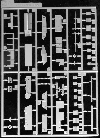 |
||||||||||||
|
|||||||||||||
| SPRUE D | |||||||||||||
| This sprue is similar to the one in the Essex kit except it has been extended on the bottom side to include the four platforms and sponsons shown below. The other items on the sprue include the walls and doors seen on the above sprue. It also included the boat cranes and deck edge elevators as well as the folding deck antenna masts. There are two different deck edge elevators; one with molded on underside detail and one without. The latter is designed for use with the included photo etch fret shown below. Again the modeler is presented with a choice in how they wish to build their ship. |  |
||||||||||||
|
|||||||||||||
| SPRUE E | |||||||||||||
| These sprues include many of the gun platforms and bridge platforms. Notice that in most cases the underside bracing is present. There are also several extra platforms that are not used on this kit. Stay tuned for details on future releases. Dragon has more in store for us in the future. Also notice the open grills in the top of the funnel cap, nice! | 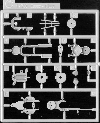 |
||||||||||||
|
|||||||||||||
| SPRUE F | |||||||||||||
| More platforms for the 20 mm guns. The other parts on this sprue are not needed for the Hancock. | 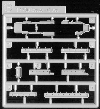 |
||||||||||||
|
|||||||||||||
| SPRUE G | |||||||||||||
| This sprue contains many platforms exclusive to the Hancock. The only ones you will need are the 40 mm guad tubs. | 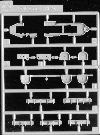 |
||||||||||||
|
|||||||||||||
| SPRUE H | |||||||||||||
|
The sprue is exclusive to the Randolph and includes some Long hull specific platform details. Notice that on the bottom of several of them are Carley Floats. |
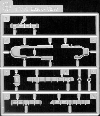 |
||||||||||||
|
|||||||||||||
| SPRUE J | |||||||||||||
| A stand is included to mount your ship on. | |||||||||||||
| SPRUE K | |||||||||||||
| This is the weapons spure and there are two of them in the kit. It includes the many anti-aircraft guns and various fittings used on the ship. Various radar's and other detail items are also included. 5" 38 cal guns are included in both open and closed types. The 40 mm guns are not bad but the gun barrels are a little thick. The 20 mm are also a little thick, but I really like the way they are molded. The front shield is offset from the pedestal and the separate gun can be mounted at any angle just like the real ones. You also get Mk-51 directors, searchlights and even some pelorus mounts. All are as fine as injections molding permits in this scale. Not to be overlooked are the nice life rafts that have some nice netting molded on. |  |
||||||||||||
|
|||||||||||||
| SPRUE L | |||||||||||||
| The island is another really nice part in this kit. The main sprue pictured below is from a very complex multi-slide mold that allows for detail to be molded on almost all sides. On a conventional mold, there are two halves and the parts need to be able to slide out of the mold. This prevents some surface detail from being included as it would be scraped off as the part was ejected out of the mold. The mold used here has what are called slides that pull from different directions. This allows detail to be cast on the sides and then before the part is ejected those parts of the mold slide out of the way preserving the detail. These types of molds are expensive and require quite an engineering effort to design. This goes to show that Dragon is committed to offering the most accurate kits to modelers and is willing to invest in the Research and Development to bring it about. |  |
||||||||||||
|
|||||||||||||
| SPRUE M | |||||||||||||
| This sprue contains some of the quad 40 mm gun tubs that mount under the flightdeck. |  |
||||||||||||
|
|||||||||||||
| SPRUE P | |||||||||||||
| This is a second weapons sprue that adds an important weapon to the kit. Specifically 20 mm twin mounts. Dragon has created a brand new fret to add this weapon that was added later in the war. Additional 40 mm guad mounts and gun directors are also added. | |||||||||||||
|
|||||||||||||
| SPRUE J | |||||||||||||
| A base is included to display your ship on should you chose to build it full hull. A nameplate is also included with a peel and stick label that fits within the border. | |||||||||||||
| PHOTOETCH | |||||||||||||
| Two photoetch frets are included that will allow you to
replace some of the molded on details. The lower frame of the deck edge
elevator and open radio antenna. You also get radar's and other platforms.
There is also a variety of deck personnel in various poses that will lend
action to your deck.
The second fret includes 20 mm gun platforms and braces. |
 |
||||||||||||
 |
|||||||||||||
| DECALS | |||||||||||||
| The decals by Cartograf include the aircraft insignia that were used during the war and include the red outlined insignia used briefly by some squadrons. The deck striping and lines are well done. They are all nicely registered and much improved from the typical kit supplied decals. | |||||||||||||
| AIRCRAFT | |||||||||||||
| The aircraft in this kit are simply the best available in this scale. They are molded in clear plastic so you can mask off the canopies and when you paint them. When the paint dries you peel off the masking and are presented with a nice clear canopy. These aircraft also benefit from the CAD technology |  |
||||||||||||
|
|
|||||||||||||
| INSTRUCTIONS | |||||||||||||
The instructions are an eight page booklet showing the
assembly in a step by step process that is easy to follow. Very thorough
and well illustrated. Camouflage is shown in three schemes. Measure 22,
21, and 32.
|
|||||||||||||
| BONUS SPRUE | |||||||||||||
| Here's another nice touch, a bonus tug boat to help you dock this carrier. It will help give you an idea of this ships imense size when displayed alongside the carrier. This tug is not just an extra thrown in, it is an all new mold produced with the slide molding technology that is fast making Dragon famous. |  |
||||||||||||
|
|||||||||||||
| REFERENCE | |||||||||||||
The most obvious differences between the Long Hull and
Short Hull Essex Class carriers are shown below. Notice the difference
in the shape and length of the bow.
|
|||||||||||||
| CONCLUSIONS | |||||||||||||
 This
kit is extremely well designed and packed with options. The modeler has
many choices when building this kit. Full hull or waterline, Open hanger
doors or closed, clear deck or opaque, and many more. Dragon USA
lists this kit with an MSRP of $34.95 US. More than a fair price when you
consider the extras. Right now this kit gets my vote for the best 1/700
scale injection molded kit on the market today. It even improves on their
previous release the Essex. Bravo Zulu Dragon. This
kit is extremely well designed and packed with options. The modeler has
many choices when building this kit. Full hull or waterline, Open hanger
doors or closed, clear deck or opaque, and many more. Dragon USA
lists this kit with an MSRP of $34.95 US. More than a fair price when you
consider the extras. Right now this kit gets my vote for the best 1/700
scale injection molded kit on the market today. It even improves on their
previous release the Essex. Bravo Zulu Dragon. |
|||||||||||||
 |
|||||||||||||
